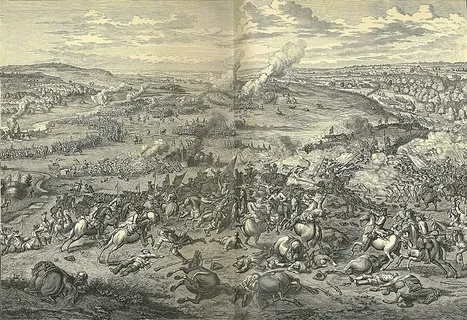The Battle of Al-Saweeq, also known as the Invasion of Sawiq, took place in the 2nd year of the Hijri calendar (around May-June 624 CE) in the aftermath of the pivotal Battle of Badr. This event was a minor but significant encounter between the Muslims of Medina, led by the Prophet Muhammad (peace be upon him), and the Quraysh polytheists of Mecca, led by Abu Sufyan ibn Harb. The battle exemplifies the tense hostilities that continued after the Muslims’ remarkable victory at Badr and provides insight into the early military struggles shaping the establishment of the Muslim community in Medina.
The battle of Al-Saweeq
The Battle of Badr had inflicted a serious defeat on the Quraysh of Mecca, killing many notable Meccan leaders and uplifting the morale of the Muslims. Abu Sufyan, a prominent Meccan chieftain who lost close relatives in Badr, vowed to avenge this humiliation. His personal vow not to bathe until he had defeated the Muslims symbolized the deep-seated determination of the Quraysh to retaliate. To fulfill this vow, Abu Sufyan assembled a force estimated between 40 and 200 cavalry horsemen and set out from Mecca.
Course of the Battle
Abu Sufyan and his band took a secretive nighttime route through the Nejd region and sought support from the Jewish tribe of Banu Nadir settled near Medina. However, the tribal chief Huwey refused them entry, fearing repercussions, but Sallam ibn Mishkam, another influential figure from the Banu Nadir, hospitably received Abu Sufyan and provided intelligence about Medina’s surroundings.
At dawn, Abu Sufyan’s men raided the Urayd farms located a few miles northeast of Medina. They ruthlessly killed two Muslims and set fire to the wheat fields, destroying vital agricultural resources belonging to the Muslim community. This sudden and merciless attack was intended to undermine the Muslims’ economic stability and morale. However, the Meccan raiders fled quickly to avoid direct confrontation with pursuing Muslim forces. To facilitate their escape, they discarded supplies, including “sawiq,” a type of coarse flour, which lent the battle its name.
The Muslims then mounted a pursuit after Abu Sufyan’s retreating force, led personally by the Prophet Muhammad. Despite efforts, the Muslims could not catch Abu Sufyan and his raiders. On their return, the Muslims collected the abandoned provisions, which was one of the few tangible “trophies” of this skirmish. The Prophet affirmed that this engagement qualified as a legitimate battle or act of jihad, despite the lack of direct combat.
Significance and Aftermath
Though relatively small in scale and lacking a decisive battle, the Battle of Al-Saweeq had important implications for the Muslim community. First, it demonstrated the continuing animosity of the Quraysh towards the Muslims following their defeat at Badr and the attempts to destabilize Medina by targeting its economic base. Second, it reinforced the resolve of the Muslims to defend their city and livelihoods, as shown by the prompt response and pursuit of the raiders. Third, it underscored the ongoing cycle of raids and counter-raids typical of Arabian warfare at the time.
The event also highlighted the complex interplay of tribal alliances. While Banu Nadir’s Huwey refused cooperation with Abu Sufyan, Sallam ibn Mishkam provided critical support, showing divisions within the Jewish tribes about siding with the Quraysh or remaining neutral. This foreshadowed the complicated relationships and conflicts that movements around Medina would face later.
Finally, this event served as a prelude to later and larger confrontations such as the Battle of Uhud, which occurred the following year, as the Quraysh did not relent in their campaign to eliminate the threat posed by the Muslims and reclaim their honor.
Read more: The battle of Waddan (1 Hijri)
FAQs
What triggered the Battle of Al-Saweeq?
The battle was triggered by the Quraysh’s desire for revenge after their defeat at the Battle of Badr. Abu Sufyan vowed to retaliate against the Muslims and launched a raid targeting Medina’s outskirts, specifically the farms of Urayd.
Who led the Quraysh force in this battle?
Abu Sufyan ibn Harb, a leading Meccan figure and commander of the Quraysh forces, led the raid aiming to avenge losses at Badr.
What was the outcome of the Battle of Al-Saweeq?
The Quraysh raiders killed two Muslims and destroyed farming property but fled without engaging in a full battle due to Muslim pursuit. The Muslims collected abandoned provisions, and Abu Sufyan escaped.
How did the Jewish tribes near Medina react to Abu Sufyan’s approach?
The Jewish tribe of Banu Nadir was divided; their chief Huwey refused Abu Sufyan entry, but Sallam ibn Mishkam provided hospitality and intelligence support.
Why is the battle called Al-Saweeq?
It is named after sawiq, a type of flour that the Quraysh raiders threw away to lighten their burden and speed their flight from the Muslim pursuit.
Conclusion
The Battle of Al-Saweeq was a brief but revealing encounter following the landmark Muslim victory at Badr. Though it resulted mainly in destruction of property and the loss of two Muslim lives without a full-scale battle, it symbolized the fierce hostility of the Quraysh towards the nascent Muslim community in Medina. The raid and subsequent pursuit by the Muslims reflected the ongoing struggle for survival and sovereignty in a turbulent environment marked by tribal loyalties and enmities. This battle, while minor compared to other engagements, underscored the determination of both sides and served as a significant episode in the early military history of Islam, paving the way for subsequent confrontations. The steadfastness of the Muslims and the leadership of the Prophet were instrumental in weathering these early challenges.

